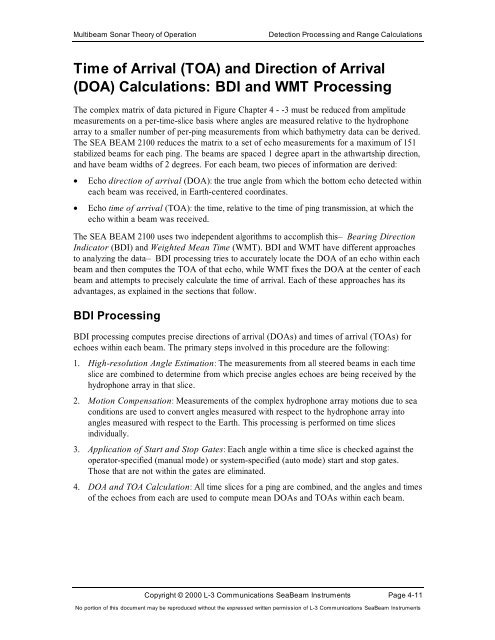Multibeam Sonar Theory of Operation
Multibeam Sonar Theory of Operation
Multibeam Sonar Theory of Operation
You also want an ePaper? Increase the reach of your titles
YUMPU automatically turns print PDFs into web optimized ePapers that Google loves.
<strong>Multibeam</strong> <strong>Sonar</strong> <strong>Theory</strong> <strong>of</strong> <strong>Operation</strong> Detection Processing and Range Calculations<br />
Time <strong>of</strong> Arrival (TOA) and Direction <strong>of</strong> Arrival<br />
(DOA) Calculations: BDI and WMT Processing<br />
The complex matrix <strong>of</strong> data pictured in Figure Chapter 4 - -3 must be reduced from amplitude<br />
measurements on a per-time-slice basis where angles are measured relative to the hydrophone<br />
array to a smaller number <strong>of</strong> per-ping measurements from which bathymetry data can be derived.<br />
The SEA BEAM 2100 reduces the matrix to a set <strong>of</strong> echo measurements for a maximum <strong>of</strong> 151<br />
stabilized beams for each ping. The beams are spaced 1 degree apart in the athwartship direction,<br />
and have beam widths <strong>of</strong> 2 degrees. For each beam, two pieces <strong>of</strong> information are derived:<br />
• Echo direction <strong>of</strong> arrival (DOA): the true angle from which the bottom echo detected within<br />
each beam was received, in Earth-centered coordinates.<br />
• Echo time <strong>of</strong> arrival (TOA): the time, relative to the time <strong>of</strong> ping transmission, at which the<br />
echo within a beam was received.<br />
The SEA BEAM 2100 uses two independent algorithms to accomplish this— Bearing Direction<br />
Indicator (BDI) and Weighted Mean Time (WMT). BDI and WMT have different approaches<br />
to analyzing the data— BDI processing tries to accurately locate the DOA <strong>of</strong> an echo within each<br />
beam and then computes the TOA <strong>of</strong> that echo, while WMT fixes the DOA at the center <strong>of</strong> each<br />
beam and attempts to precisely calculate the time <strong>of</strong> arrival. Each <strong>of</strong> these approaches has its<br />
advantages, as explained in the sections that follow.<br />
BDI Processing<br />
BDI processing computes precise directions <strong>of</strong> arrival (DOAs) and times <strong>of</strong> arrival (TOAs) for<br />
echoes within each beam. The primary steps involved in this procedure are the following:<br />
1. High-resolution Angle Estimation: The measurements from all steered beams in each time<br />
slice are combined to determine from which precise angles echoes are being received by the<br />
hydrophone array in that slice.<br />
2. Motion Compensation: Measurements <strong>of</strong> the complex hydrophone array motions due to sea<br />
conditions are used to convert angles measured with respect to the hydrophone array into<br />
angles measured with respect to the Earth. This processing is performed on time slices<br />
individually.<br />
3. Application <strong>of</strong> Start and Stop Gates: Each angle within a time slice is checked against the<br />
operator-specified (manual mode) or system-specified (auto mode) start and stop gates.<br />
Those that are not within the gates are eliminated.<br />
4. DOA and TOA Calculation: All time slices for a ping are combined, and the angles and times<br />
<strong>of</strong> the echoes from each are used to compute mean DOAs and TOAs within each beam.<br />
Copyright © 2000 L-3 Communications SeaBeam Instruments Page 4-11<br />
No portion <strong>of</strong> this document may be reproduced without the expressed written permission <strong>of</strong> L-3 Communications SeaBeam Instruments
















